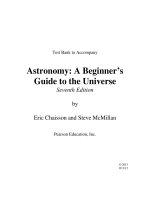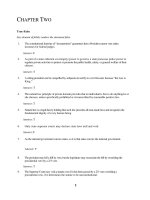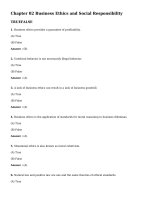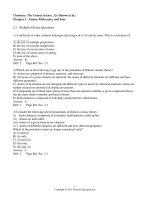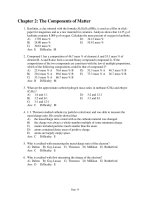Chemistry the molecular nature of matter 7th edition jespersen test bank
Bạn đang xem bản rút gọn của tài liệu. Xem và tải ngay bản đầy đủ của tài liệu tại đây (222.22 KB, 31 trang )
Chapter 0
A Very Brief History of Chemistry
Multiple Choice Questions
1. Which of the following is the logical progression of elements formed in a star?
a.
b.
c.
d.
e.
Hydrogen Helium Argon Carbon
Hydrogen Helium Carbon Argon
Helium Hydrogen Argon Carbon
Helium Hydrogen Carbon Argon
Argon Carbon Helium Hydrogen
Answer: b
Section 0.2
Difficulty Level: medium
2. Why is iron the heaviest element formed in a star prior to a super nova?
a. The formation of iron in a star starts a cooling process of the star, ending
nucleosynthesis.
b. Iron reacts with the hydrogen in stars to cause a violet explosion which leads to a
super nova.
c. Iron is the heaviest element that is stable at high temperatures, all others are
radioactive.
d. The formation of iron in a star causes a reaction with helium that causes
nucleosynthesis to end.
e. When iron is formed in the outer layers of a star is has enough kinetic energy to
leave the gravity of the star and therefore is able to remove itself from the star.
Answer: a
Section 0.2
Difficulty Level: medium
0-1
3. One would expect a fairly even distribution of elements on earth; instead we see an uneven
distribution of elements through the earth. Which of the following best describes why we
observe this?
a. The nebula that formed the earth had elements that were not evenly distributed.
b. Winds on the surface of the earth have moved around the heavy and light
elements into bands.
c. The early earth liquefied, resulting in heavier elements migrating towards the
core, and lighter elements towards the surface. This migration to the surface was
largely by lava flows, which were inconsistent.
d. Some elements were soluble in water washed them into pockets on the surface.
e. The magnetic properties of the core caused the metals to pool into certain areas
between the poles on earth.
Answer: c
Section 0.2
Difficulty Level: medium
4.
The relative number of atoms of each element in a particular compound
a.
b.
c.
d.
e.
is always l:l.
is the same as the density ratio.
is the same as the weight ratio.
is definite and constant.
cannot be determined experimentally.
Answer: d
Section 0.4
Difficulty Level: easy
0-2
5.
Which of the following postulates from Dalton’s atomic theory are now considered
incorrect?
I. All the atoms of a given element are identical.
II. Matter consists of very small particles known as atoms.
III. Atoms are indestructible and also indivisible.
a.
b.
c.
d.
e.
III only.
II only.
I only.
I and II
I and III
Answer: e
Section 0.4
Difficulty Level: medium
6.
Which of the following statements is/are consistent with Dalton’s atomic theory?
I.
The atoms in a given sample of an element do not share any common
properties.
II. Matter consists of particles called atoms.
III. In chemical reactions, atoms merely rearrange, but do not disintegrate.
a.
b.
c.
d.
e.
III only.
II only.
I only.
II and III
I and III
Answer: d
Section 0.4
Difficulty Level: medium
0-3
7.
Which of the following statements is/are NOT consistent with Dalton’s atomic theory?
I.
The atoms in a given sample of an element do not share any common
properties.
II. Matter consists of tiny particles called molecular substances.
III. In chemical reactions, atoms merely rearrange, but do not disintegrate.
a.
b.
c.
d.
e.
III only.
II only.
I only.
II and III
I and II
Answer: e
Section 0.4
Difficulty Level: medium
8.
Which of the following postulates from Dalton’s atomic theory is incorrectly stated?
a.
b.
c.
d.
The atoms in a given sample of an element are identical.
Matter consists of tiny particles called atoms.
In chemical reactions, atoms merely rearrange, but do not disintegrate.
In a given chemical compound, the atoms can be present in various numerical
ratios.
e. In a given chemical compound, the atoms are always present in the same fixed
numerical ratio.
Answer: d
Section 0.4
Difficulty Level: medium
0-4
9.
Which of the following is consistent with the postulates from Dalton’s atomic theory?
a. The atoms in a given sample of an element are not necessarily identical.
b. Matter consists of tiny particles called ions.
c. In chemical reactions, atoms not only rearrange, but also disintegrate in smaller
subatomic particles.
d. In a given chemical compound, the atoms can be present in various numerical
ratios.
e. In a given chemical compound, the atoms are always present in the same fixed
numerical ratio.
Answer: e
Section 0.4
Difficulty Level: medium
10. Which one of the statements below is true?
a. When two atoms combine to form a chemical compound, they do so in many
different proportions by mass.
b. When two different compounds combine to form an element, they do so in
definite proportions by mass.
c. When two different elements combine to form a chemical compound, they do so
in definite proportions by mass.
d. When two molecules combine in a chemical reaction, a number of different
elements can be generated depending on the masses used.
e. When two different elements combine to form a mixture, they do so in definite
proportions by weight.
Answer: c
Section 0.4
Difficulty Level: medium
0-5
11. Which one of the statements below is false?
a. In chemical reactions, atoms are rearranged.
b. In a given compound, the atoms are always present in the same fixed numerical
ratio.
c. Matter is made up of tiny particles called atoms.
d. In a sealed reaction flask, the total mass after the reaction is over, is the same as
before the reaction started.
e. When hydrogen and oxygen react to form water, the mass of oxygen is equal to
the mass of hydrogen.
Answer: e
Section 0.4
Difficulty Level: medium
12.
Which of the following examples is consistent with the postulates from Dalton’s atomic
theory?
a. The atoms in a sample of chlorine are similar to the atoms in a sample of
elemental sulfur.
b. Matter consists of extremely tiny particles which are either positively or
negatively charged.
c. When water is formed from oxygen and hydrogen molecules, the atoms in water
are grouped differently compared to those in hydrogen and oxygen.
d. When a sample of water is analyzed, it is discovered that the hydrogen and the
oxygen atoms are combined in only two different ratios by mass.
e. There are eight different types of sulfur atoms in any naturally occurring sample
of elemental sulfur.
Answer: c
Section 0.4
Difficulty Level: hard
0-6
13.
In the formation of hydrogen sulfide, H2S, from hydrogen and sulfur 4.03 g of hydrogen
are reacted with 62.13 g of sulfur. If all of the hydrogen and sulfur completely react to
form hydrogen sulfide how many grams of hydrogen sulfide should be formed?
a. 66.16 g
b. 58.10 g
c. 4.03 g
d. 70.19 g
e. 33.03 g
Answer: a
Section 0.4
Difficulty Level: medium
14.
Which of these scientists developed the atomic theory?
a. John Dalton
b. J. J. Thomson
c. Robert Millikan
d. Henry Moseley
e. Ernest Rutherford
Answer: a
Section 0.4
Difficulty Level: medium
15.
When J. J. Thomson discovered the electron, what physical property of the electron did he
measure?
a. Its charge.
b. Its charge-to-mass ratio.
c. Its temperature.
d. Its mass.
e. Its atomic number.
Answer: b
Section 0.4
Difficulty Level: medium
0-7
16. Which one of the following contributes to the charge, but does NOT contribute significantly
to the mass of an atom?
a.
b.
c.
d.
e.
electrons
nuclei
photons
neutrons
protons
Answer: a
Section 0.5
Difficulty Level: easy
17. Which of the following have roughly the same mass?
a.
b.
c.
d.
e.
A proton and an electron.
A neutron and an electron.
A neutron and a proton.
An electron and an alpha particle.
None of these options.
Answer: c
Section 0.5
Difficulty Level: easy
18.
Which of the following have equal, but opposite, electronic charges?
a.
b.
c.
d.
e.
A proton and an electron.
A neutron and an electron.
A neutron and a proton.
An electron and an alpha particle.
None of these options.
Answer: a
Section 0.5
Difficulty Level: easy
0-8
19. Consider the atoms of 65Cu and 65Zn. Both of these atoms have the same
a.
b.
c.
d.
e.
number of electrons.
number of ions.
number of neutrons.
mass number.
number of protons.
Answer: d
Section 0.5
Difficulty Level: easy
20.
Which of the following particles will not be deflected by charged plates?
a.
b.
c.
d.
e.
hydrogen atoms
cathode rays
alpha particles
protons
These are all deflected by charged plates.
Answer: a
Section 0.5
Difficulty Level: medium
21. Uranium exists in nature in the form of several isotopes; the different isotopes have different
a. atomic numbers.
b. charges.
c. numbers of electrons.
d. numbers of neutrons.
e. numbers of protons.
Answer: d
Section 0.5
Difficulty Level: medium
0-9
22. Two isotopes of an element differ only in their
a.
b.
c.
d.
e.
symbol.
atomic number.
atomic mass.
number of protons.
number of electrons.
Answer: c
Section 0.5
Difficulty Level: easy
23. Which answer below best describes all atoms of a given isotope of a particular element?
a. They possess the same mass, only.
b. They possess the same chemical properties and the same mass, but nothing else in
common.
c. They possess the same atomic number and the same mass, but have nothing else
in common.
d. They possess the same number of electrons, the same atomic number, the same
mass, but nothing else in common.
e. They possess the same number of electrons, the same atomic number, the same
mass, and the same chemical properties.
Answer: e
Section 0.5
Difficulty Level: medium
0-10
24. Which answer below best describes all atoms of a particular element?
a. They possess the same number of electrons, the same atomic number, the same
mass, but nothing else in common.
b. They possess the same mass and the same chemical properties, but nothing else in
common.
c. They possess the same number of electrons, the same atomic number, the same
chemical properties, but not necessarily the same mass.
d. They possess the same chemical properties and the same mass, but nothing else in
common.
e. They possess the same atomic number and the same mass, but have nothing else
in common.
Answer: c
Section 0.5
Difficulty Level: medium
25.
The species shown below which has 24 neutrons is
a.
b.
c.
d.
e.
52
24
55
25
24
12
45
21
51
23
Cr
Mn
Mg
Sc
V
Answer: d
Section 0.5
Difficulty Level: medium
26. The species shown below which has 24 electrons is
a.
b.
c.
d.
e.
52
24
55
25
24
12
45
21
51
23
Cr
Mn
Mg
Sc
V
Answer: a
Section 0.5
Difficulty Level: medium
0-11
51
23
V , has the same number of neutrons as
27. The species,
a.
b.
c.
d.
e.
50
23
45
21
55
25
52
24
59
27
V
Sc
Mn
Cr
Co
Answer: d
Section 0.5
Difficulty Level: medium
28. Consider the atoms of
a.
b.
c.
d.
e.
26
12
Mg and
27
13
Al . Both of these species have the same
number of neutrons and electrons.
number of ions.
number of neutrons.
number of neutrons and mass number.
number of protons and electrons.
Answer: c
Section 0.5
Difficulty Level: medium
29. Consider the atoms of 59Co and 60Co. Both of these atoms have the same
a.
b.
c.
d.
e.
number of neutrons and electrons.
number of neutrons and ions.
mass number.
number of photons.
number of protons and electrons.
Answer: e
Section 0.5
Difficulty Level: medium
0-12
30.
33
An atom of the isotope sulfur-33( 16 S ) consists of how many protons, neutrons, and
electrons? The atomic number of sulfur is 16. (p = proton, n = neutron, e = electron)
a. 15 p, 18 n, 15 e
b. 16 p, 17 n, 16 e
c. 33 p, 16 n, 33 e
d. 16 p, 16 n, 33 e
e. 16 p, 33 n, 16 e
Answer: b
Section 0.5
Difficulty Level: easy
31.
35
An atom of the isotope chlorine-35 ( 17 Cl ) consists of how many protons, neutrons, and
electrons? The atomic number of chlorine is 17. (p = proton, n = neutron, e = electron)
a. 17 p, 35 n, 17 e
b. 17 p, 17 n, 35 e
c. 18 p, 17 n, 18 e
d. 17 p, 18 n, 17 e
e. 35 p, 17 n, 18 e
Answer: d
Section 0.5
Difficulty Level: easy
27
32. Compare 26
12 Mg and 13 Al . In what respect do these species differ?
I. number of neutrons, and number of electrons.
II. number of protons, and number of neutrons.
III. mass number and number of protons.
a.
b.
c.
d.
e.
I only
II only
III only
I and III
I, II, and III
Answer: c
Section 0.5
Difficulty Level: medium
0-13
33.
A neutral iodine atom has an atomic mass number = 131. Which description below fits this
atom?
a.
b.
c.
d.
e.
39 protons, 78 neutrons, 39 electrons
53 protons, 78 neutrons, 53 electrons
52 protons, 79 neutrons, 54 electrons
53 protons, 131 neutrons, 53 electrons
54 protons, 131 neutrons, 54 electrons
Answer: b
Section 0.5
Difficulty Level: medium
34. Which description below fits the 65Cu atom?
a.
b.
c.
d.
e.
29 protons, 65 neutrons, 29 electrons
29 protons, 36 neutrons, 65 electrons
29 protons, 36 neutrons, 31 electrons
29 protons, 36 neutrons, 29 electrons
31 protons, 34 neutrons, 29 electrons
Answer: d
Section 0.5
Difficulty Level: medium
35. Which description below fits the 112Cd atom?
a.
b.
c.
d.
e.
48 protons, 64 neutrons, 48 electrons
48 protons, 62 neutrons, 48 electrons
48 protons, 64 neutrons, 46 electrons
48 protons, 62 neutrons, 46 electrons
50 protons, 64 neutrons, 48 electrons
Answer: a
Section 0.5
Difficulty Level: medium
0-14
36. The atomic mass of naturally occurring iron, which is a mixture of isotopes, is listed as
55.847 u. This means that the average mass of iron is
a.
b.
c.
d.
e.
55.847 times as great as that of a 12C atom
55.847 times as great as that of a 1H atom
55.847/1.0079 times as great as that of a 1H atom
55.847/12.000 times as great as that of a 12C atom
55.847/12.011 times as great as that of a 12C atom
Answer: d
Section 0.5
Difficulty Level: medium
37. The atomic mass of naturally occurring nickel, which is a mixture of isotopes, is listed as
58.6934 u. This means that the average mass of nickel is
a.
b.
c.
d.
e.
58.6934 times as great as that of a 12C atom
58.6934 times as great as that of a 1H atom
58.6934/1.0079 times as great as that of a 1H atom
58.6934/12.000 times as great as that of a 12C atom
58.6934/12.011 times as great as that of a 12C atom
Answer: d
Section 0.5
Difficulty Level: medium
38. The atomic mass of naturally occurring silver, which is a mixture of two isotopes, is listed as
107.868 u. This means that
a. all silver atoms found in nature have a mass which is 107.868/12.000 times as
great as that of a 12C atom.
b. all silver atoms found in nature have a mass which is 107.868/1.0079 times as
great as that of a 1H atom.
c. some silver atoms found in nature have a mass which is 107.868/12.000 times as
great as that of a 12C atom.
d. some silver atoms found in nature have a mass which is 107.868/1.0079 times as
great as that of a 1H atom.
e. no silver atoms found in nature has a mass which is 107.868/12.000 times as great
as that of a 12C atom.
Answer: e
Section 0.5
Difficulty Level: medium
0-15
39. The atomic mass of naturally occurring copper, which is a mixture of two isotopes, is listed
as 63.546 u. This means that
a. all copper atoms found in nature have a mass which is 63.546/12.000 times as
great as that of a 12C atom.
b. all copper atoms found in nature have a mass which is 63.546/1.0079 times as
great as that of a 1H atom.
c. some copper atoms found in nature have a mass which is 63.546/12.000 times as
great as that of a 12C atom.
d. some copper atoms found in nature have a mass which is 63.546/1.0079 times as
great as that of a 1H atom.
e. no copper atoms found in nature has a mass which is 63.546/12.000 times as great
as that of a 12C atom.
Answer: e
Section 0.5
Difficulty Level: medium
40. The atomic mass of naturally occurring gallium, which is a mixture of two isotopes, is listed
as 69.723 u. This means that
a. all gallium atoms found in nature have a mass which is 69.723/12.000 times as
great as that of a 12C atom.
b. all gallium atoms found in nature have a mass which is 69.723/1.0079 times as
great as that of a 1H atom.
c. some gallium atoms found in nature have a mass which is 69.723/12.000 times as
great as that of a 12C atom.
d. some gallium atoms found in nature have a mass which is 69.723/1.0079 times as
great as that of a 1H atom.
e. no gallium atoms found in nature has a mass which is 69.723/12.000 times as
great as that of a 12C atom.
Answer: e
Section 0.5
Difficulty Level: medium
0-16
41. The atomic mass of naturally occurring fluorine, which exists in nature as a single isotope, is
listed as 18.9984 u. This means that
a. all fluorine atoms found in nature have a mass which is 18.9984/12.000 times as
great as that of a 12C atom.
b. all fluorine atoms found in nature have a mass which is 18.9984/1.0079 times as
great as that of a 1H atom.
c. some fluorine atoms found in nature have a mass which is 18.9984/12.000 times
as great as that of a 12C atom.
d. some fluorine atoms found in nature have a mass which is 18.9984/1.0079 times
as great as that of a 1H atom.
e. no fluorine atom found in nature has a mass which is 18.9984/12.000 times as
great as that of a 12C atom.
Answer: a
Section 0.5
Difficulty Level: medium
42.
The atomic mass of naturally occurring cobalt, which exists in nature as a single
isotope, is listed as 58.9332 u. This means that
a. all cobalt atoms found in nature have a mass which is 58.9332/12.000 times as
great as that of a 12C atom.
b. all cobalt atoms found in nature have a mass which is 58.9332/1.0079 times as
great as that of a 1H atom.
c. some cobalt atoms found in nature have a mass which is 58.9332/12.000 times as
great as that of a 12C atom.
d. some cobalt atoms found in nature have a mass which is 58.9332/1.0079 times as
great as that of a 1H atom.
e. no cobalt atom found in nature has a mass which is 58.9332/12.000 times as great
as that of a 12C atom.
Answer: a
Section 0.5
Difficulty Level: medium
0-17
43. A naturally occurring element consists of three isotopes. The data for the isotopes are:
isotope 1: 46.972 u, 69.472%
isotope 2: 48.961 u, 21.667%
isotope 3: 49.954 u, 8.8610%
What is the average atomic mass of this naturally occurring element?
a.
b.
c.
d.
e.
47.667 u
47.699 u
48.629 u
48.667 u
48.961 u
Answer: a
Section 0.5
Difficulty Level: hard
44. A naturally occurring element consists of three isotopes. The data for the isotopes are:
isotope 1: 146.9672 u, 64.792%
isotope 2: 148.9638 u, 26.117%
isotope 3: 149.9592 u, 9.0910%
What is the average atomic mass of this naturally occurring element?
a.
b.
c.
d.
e.
49.254 u
147.76 u
148.63 u
148.67 u
147.88 u
Answer: b
Section 0.5
Difficulty Level: hard
0-18
45. A naturally occurring element consists of three isotopes. The data for the isotopes are:
isotope 1: 187.9122 u., 10.861%
isotope 2: 190.9047 u, 12.428%
isotope 3: 192.8938 u, 76.711%
What is the average atomic mass of this naturally occurring element?
a.
b.
c.
d.
e.
64.035 u
190.57 u
190.67 u
192.08 u
192.11 u
Answer: e
Section 0.5
Difficulty Level: hard
46. A naturally occurring element consists of three isotopes. The data for the isotopes are:
isotope 1: 147.9554 u, 10.563%
isotope 2: 150.9496 u, 70.811%
isotope 3: 152.9461 u, 18.626%
What is the average atomic mass of this naturally occurring element?
a.
b.
c.
d.
e.
50.335 u
150.62 u
150.67 u
151.01 u
151.08 u
Answer: d
Section 0.5
Difficulty Level: hard
0-19
47. A naturally occurring element consists of two isotopes. The data for the isotopes are:
isotope 1 68.5257 u 60.226 %
isotope 2 70.9429 u ?????? %
Calculate the average atomic mass of this element.
a.
b.
c.
d.
e.
69.728 u
69.743 u
69.934 u
69.972 u
70.141 u
Answer: a
Section 0.5
Difficulty Level: hard
Fill-in-the-Blank Questions
48. Chemistry has four main ideas that were given in chapter 0. List them.
Answer: 1. Dalton’s Atomic theory. 2. The atomic scale is reflected in the macroscopic world.
3. Energy changes and probability allow us to understand why chemicals react. 4. The 3-D
structure of molecules often dictates their function.
Section 0.1
Difficulty Level: medium
49.
Planets are formed after supernovas from _______ left over from the formation of a new
star.
Answer: debris
Section 0.3
Difficulty Level: easy
50.
The large dust clouds that formed planets were called ________.
Answer: nebula
Section 0.3
Difficulty Level: easy
0-20
51. Molecules are made of tiny particles called ___________ .
Answer: atoms
Section 0.4
Difficulty Level: easy
52. There is no detectable gain or loss in mass in chemical reactions. This is the________.
Answer: Law of Conservation of Mass
Section 0.4
Difficulty Level: easy
53. In a chemical compound, the elements are always combined in the same proportions by
__________ .
Answer: mass
Section 0.4
Difficulty Level: easy
54. A compound is made of nitrogen and hydrogen in a ratio of 5.65 grams nitrogen to 1.22
grams of hydrogen. There are __________ grams of nitrogen in a sample of this compound
containing 4.00 grams of hydrogen.
Answer: 18.5
Section 0.4
Difficulty Level: hard
55. A compound is made of nitrogen and hydrogen in a ratio of 22.6 grams nitrogen to 4.88
grams of hydrogen. There are __________ grams of hydrogen in a sample of the compound
containing 12.6 grams of nitrogen.
Answer: 2.72
Section 0.4
Difficulty Level: hard
0-21
56. A compound of phosphorus and chlorine contains 3.00 grams of phosphorus and 10.3 grams
of chlorine. There are __________ grams of phosphorus in a sample of the compound
containing 17.2 grams of chlorine.
Answer: 5.01
Section 0.4
Difficulty Level: hard
57. A compound of phosphorus and chlorine contains 3.00 grams of phosphorus and 10.3 grams
of chlorine. There are __________ total grams of the compound in a sample which contains
4.00 grams of chlorine.
Answer: 5.17
Section 0.4
Difficulty Level: hard
58. If 2.00 grams of hydrogen react with 16.00 grams of oxygen to form water, how many
grams of water must be formed if all of the hydrogen and oxygen react?
Answer: 18.00 g
Section 0.4
Difficulty Level: medium
59. The particles found in nuclei, the protons and neutrons, are collectively called _______ .
Answer: nucleons
Section 0.5
Difficulty Level: easy
60. Which subatomic particle has a single unit of positive charge? ______
Answer: proton
Section 0.5
Difficulty Level: easy
0-22
61. How many electrons are in an atom of 35Cl?
__________
Answer: 17
Section 0.5
Difficulty Level: easy
62. How many nucleons are in an atom of 40K?
__________
Answer: 40
Section 0.5
Difficulty Level: medium
63.
The element chlorine has two main isotopes that result in almost all chlorine on earth. The
two are listed below with their atomic masses. The average atomic mass of chlorine is
listed as 35.453 u. Using this information what is the relative abundances of the two
chlorine isotopes?
Chlorine-35: 34.969 u
Chlorine-37: 36.966 u
Answer: Chlorine-35, 75.8%; Chlorine-37, 24.2%
Section 0.5
Difficulty Level: hard
64.
The element bromine has two main isotopes that result in almost all bromine on earth. The
two are listed below with their atomic masses. The average atomic mass of bromine is
listed as 79.904 u. Using this information what is the relative abundances of the two
chlorine isotopes?
Bromine-79: 78.918 u
Bromine-81: 80.916 u
Answer: Bromine-79, 50.7%; Bromine-81, 49.3%
Section 0.5
Difficulty Level: hard
0-23
True and False Questions
65. Microwave radiation observed by Penzias and Wilson in 1964 helps to support the big-bang
theory because it observed microwave radiation that was characteristic of a temperature
that matched the predicted temperature of the universe after heating up for 14 billion years.
Answer: False
Section 0.2
Difficulty Level: medium
66. Stars that are classified as red giants are formed after the outer layer of hydrogen in a star
cools and is no longer white hot.
Answer: True
Section 0.2
Difficulty Level: medium
67. In stars the heaviest elements migrate to the outer layers of the star due to centrifugal forces.
Answer: False
Section 0.2
Difficulty Level: easy
68. Atoms are made of tiny particles called molecules.
Answer: False
Section 0.4
Difficulty Level: easy
69. In any given chemical compound, elements can be combined in various amounts by mass.
Answer: False
Section 0.4
Difficulty Level: easy
0-24
70. When a piece of paper burns in a closed container, the combined masses of the products is
less than the mass of the original piece of paper.
Answer: False
Section 0.4
Difficulty Level: medium
71. Atoms must undergo disintegration followed by rearrangement, in order for chemical
reactions to occur.
Answer: False
Section 0.4
Difficulty Level: medium
72.
The hydrogen atom minus an electron is known as the proton.
Answer: True
Section 0.5
Difficulty Level: easy
73.
Almost the entire mass of an atom is concentrated in a very large volume outside the center
of the atom.
Answer: False
Section 0.5
Difficulty Level: easy
74.
In a neutral atom, the number of protons must equal the number of neutrons.
Answer: False
Section 0.5
Difficulty Level: easy
75.
At the nanoscale level, the structures under investigation usually have dimensions of tens to
hundreds of atoms.
Answer: True
Section: On the Cutting Edge 0.1
Difficulty Level: medium
0-25
